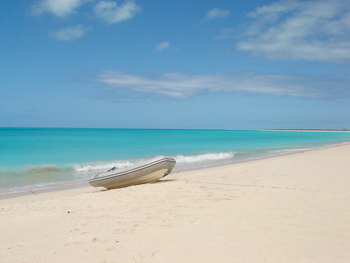
St. John's, Antigua
&
Frigate birds in Barbuda
February 2009
Part Three
| |
| HOME |
| About Tenaya |
| About Us |
| Latest Update |
| Logs from Current Year |
| Logs from Previous Years |
| Katie's View |
| Route Map |
| Links |
| Contact Us |
![]()
March 13 , 2009
Winds were light so we motored the 22 miles from English Harbor to St. John's, Antigua on March 10. Reefs and shoals abound around these northern islands so we must keep a good watch and follow our course carefully.
The anchorage at St. John's is at the head of a long commercial harbor. It is convenient to explore the bustling capital, the island's only real city. While it is not pretty, St. John's has a certain work-a-day charm. Redcliffe Quay, the waterfront near the cruise ship dock, is packed full of shops housed in attractively restored colonial buildings. We took a bus down to Jolly Harbor to see a little of the island and to have a look at Tom's boat moored in the marina.
Elections occur in Antigua and Barbuda (one country) every 5 years and Thursday is election day. Cars with enormous loud speakers roamed the island spreading the candidates' messages and signs and billboards are everywhere. Loudly broadcast speeches and music went on until 4:00 a.m.
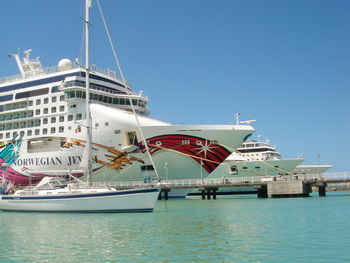
Tenaya and the big boys at St. John's harbor, Antigua
We awoke early the next morning for the 41 mile trip to Barbuda. Heading NE on a close reach, we were able to sail more than half way until the wind backed to right on the nose. Tacking would take too long and require more effort than we were willing to expend. On went the motor and down went the sails as Jim programmed the GPS to take us safely in. We have wondered why people motor on perfectly good sailing days, even if sailing to windward, and now we have done the same. Call us lazy.
Barbuda is not well protected so should only be visited in calm conditions. High seas from the north can be uncomfortable and even dangerous. It is not well charted either. The warning on our charts "Taken from British Admiralty surveys of 1848" did nothing to inspire confidence, nor did the comment from the pilot book "Unless you proceed with your heart in your mouth, you may be getting overconfident." The least difficult anchorage to navigate is at Low Bay along the northwestern coast. Keeping one eye on the depth gauge and a close watch ahead for changes in water color we proceeded cautiously. Occasional clouds cast large shadows, darkening all in front of the boat and hiding anything we could hit. Slight panic ensued until the sun shone brightly again.
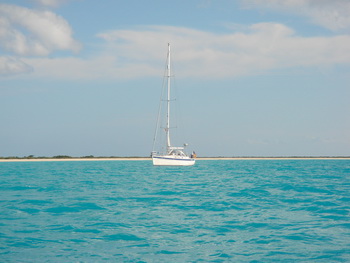
Tenaya anchored at Eleven Mile Beach, Barbuda
Barbuda is absolutely beautiful, exactly as a deserted Caribbean island should look. Bright, clear turquoise water studded with reefs, shoals and coral heads laps calmly against long, pink sandy shores edged in low, green brush. As our guide book says, "Since it is seldom visited and not commercial, no glossy brochures proclaim it to be the most beautiful beach in the Caribbean, but it probably is."
A row of footprints shows another person has come ashore recently and one small hotel stands on the otherwise pristine spit of land. Pink sand stretches eleven miles and we see no other people on shore although there are a handful of boats anchored here and there. The island is low, the highest point only 125 feet. Scrubby brush is home to donkeys, horses, deer and wild boar. Frigate birds soar high above and pelicans plummet to the sea in search of food. We can easily pretend we are on a deserted island.
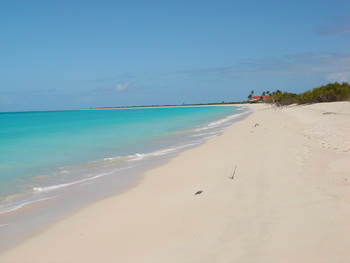
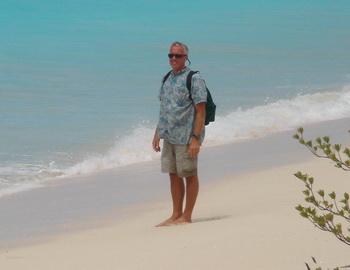
1600 people live on the island. Most live in the capital of Codrington just across the 2 mile wide and 7 mile long lagoon. Owning the island communally, the citizens have fought diligently to keep their way of life and avoid growth and exploitment. Fishing and farming sustain the residents and signs of tourism are few and far between. The Barbudans appear content with their lives, greatly value the beauty of their surroundings, and lack the greed to succumb to developers majestic dreams.
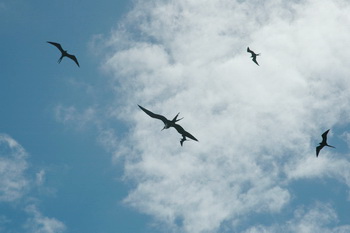
Frigate birds soar overhead

Pelicans nest in the mangroves
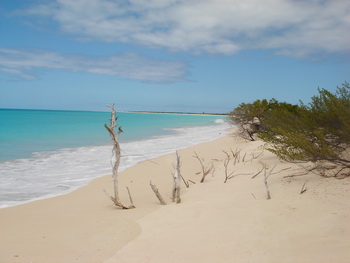
The tranquil beach
.
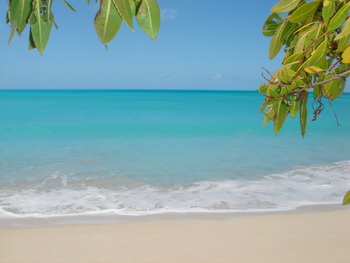
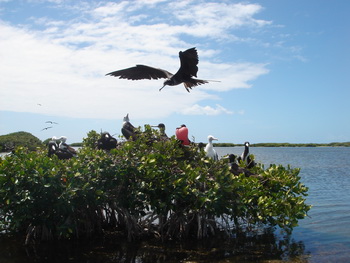
One of the main reasons we wanted to visit the pristine island of Barbuda was to see the frigate bird colony. Local lobster fisherman and guide, George Jeffrey, gave us a wonderful tour in his sturdy taxi boat. He began by explaining that pelicans and frigate birds live in the mangroves which grow in the lagoon. Periodically patches of mangroves are upended in hurricanes, killing the larger trees but allowing the smaller ones to survive. The frigates all live together so when their nests are destroyed they move collectively to a new location in the mangroves. Pelicans, on the other hand, will live scattered about the mangroves in different areas. George took us to places where both birds nest.
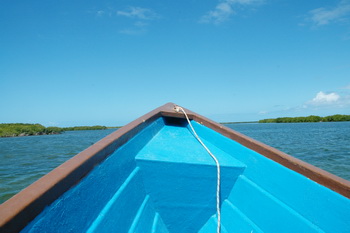
On to the mangroves
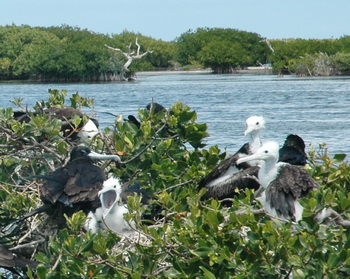
Look at the size of that mouth!
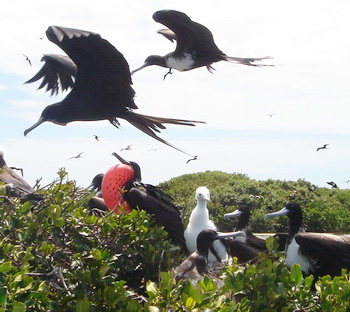
Hoping to get lucky ...
Males frigate birds attract females by puffing up their red chests. Although mating season is officially over and chicks have already hatched, several males were still showing off. Males are all black, females are black with white chests, juveniles up to two years old are black with white heads and chests, and chicks are mostly white.
Frigate birds, also known as man o' war birds, cannot take off from the water. They feed by catching flying fish or harassing other birds into dropping their catches. With bodies weighing 2-3 pounds, frigates have the largest wing area in proportion to their body weight of any bird. They are gorgeous in flight, soaring high with their large curved wings and split tails.
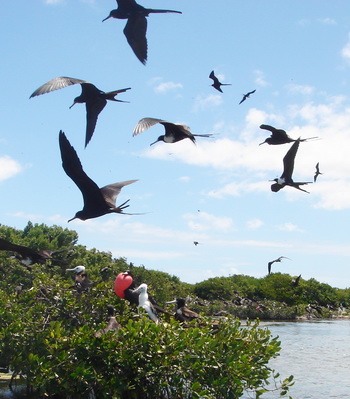
20,000 frigate birds inhabit the Barbuda colony
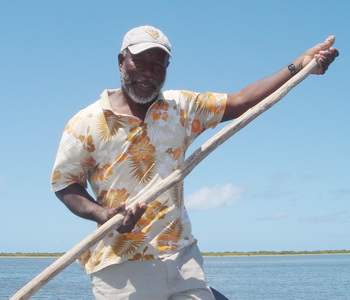
Our guide, George Jeffrey
George stopped by a large red buoy floating askew in the lagoon. It just appeared one day. Turns out it was originally from the east coast of Canada, had broken free in a storm and traveled the currents of the Atlantic across to Spain and back again to the Caribbean where it came ashore here in Barbuda. A dent in the side is evidence that at least one boat hit it. A sailor's worst nightmare.
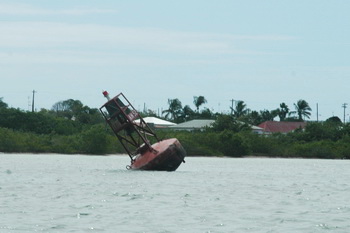
Buoy that broke loose in Canada and ended up here
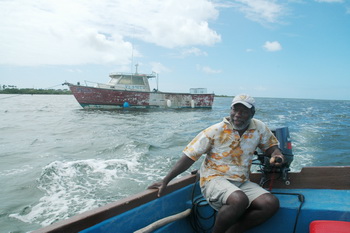
George Jeffrey with his lobster boat in the background
Looking at the GRIB files on the afternoon of our second day in Barbuda, we became concerned about the growing wave height. This is no place to be in large swells so we decided to leave at 6:00 pm and sail overnight to St. Bart's 60 miles away. With a full moon it should be a lovely sail.
Go to March Part Four - St. Barts
.